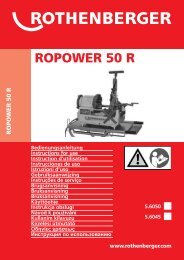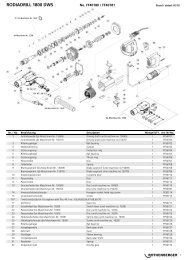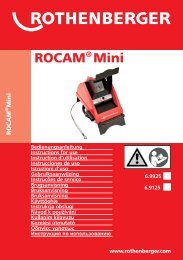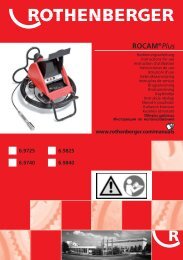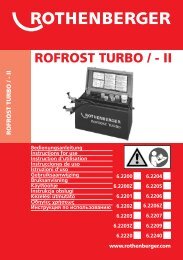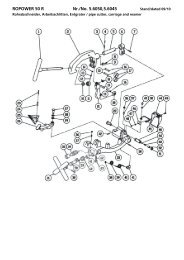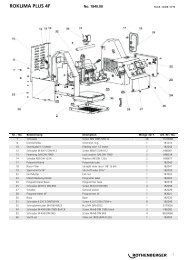You also want an ePaper? Increase the reach of your titles
YUMPU automatically turns print PDFs into web optimized ePapers that Google loves.
Attaching the pipe saw to the pipe<br />
Open the pipe saw’s gripper unit enough to suit the<br />
diameter of the pipe by rotating the adjustment handle<br />
located at the rear of the saw (Fig. E/1).<br />
Position the pipe saw on top of the pipe so that the<br />
edge of the lower blade guard is at the cutting mark.<br />
Fasten the pipe saw to the pipe by turning the gripper<br />
adjustment handle until the gripper grips firmly the<br />
pipe to be cut (Figure E/2). Hold the pipe in place and<br />
ensure that pipe saw moves freely in the direction the<br />
pipe is fed. For sake of safety ensure the pipe saw leads<br />
are to the left of the pipe saw. The pipe saw is now<br />
ready for cutting.<br />
Fig. E<br />
Piercing the pipe wall<br />
Grip the gripper firmly with your right hand and place<br />
your left foot on top of the pipe approximately 50cm<br />
from the pipe saw. Turn the saw until it leans slightly<br />
forward (Figure H). When starting the motor, first of<br />
Fig. F<br />
Fig. G<br />
17<br />
OPERATING INSTRUCTIONS<br />
GB<br />
all release the power-switch locking lever (Fig F/1) and<br />
push the power switch all the way down (Fig F/2).<br />
Before starting to saw, wait until the blade reaches<br />
full speed. Pierce the pipe wall by pressing pipe saw<br />
operating handle downwards slowly and evenly until<br />
the blade has cut through the pipe wall (at this stage<br />
the pipe must not rotate) and the motor unit is locked<br />
in the sawing position (Fig H/1).<br />
Look at the UNLOCK button during the piercing<br />
operation. When UNLOCK button is locked, i.e. the<br />
yellow mark disappears (Fig G), pipe saw is locked in<br />
the sawing position, and you can safely start sawing<br />
around the pipe.<br />
Sawing around the pipe<br />
Start sawing by feeding the pipe saw forward and fix<br />
the pipe with your left foot (Fig H/3). After that release<br />
the pipe (remove your left foot from the pipe) and<br />
turn the pipe saw backwards, whereby the pipe will<br />
also be rotated backwards (Fig J). Start a new feeding<br />
movement, and feed continuously forward ca. 1/6 of<br />
the pipe’s circumference. Repeat until the pipe is cut<br />
off (Fig K).<br />
Select the sawing speed as per the material and the<br />
thickness of the wall. Too high speed can damage the<br />
blade, overload the pipe saw and give a poor sawing<br />
result.<br />
When the pipe is cut off, push the UNLOCK button<br />
forward until the yellow mark is visible and the locking<br />
is released (Fig L/1). Now raise the motor unit to<br />
starting position (Fig L/2). Release the power switch<br />
Fig. H



